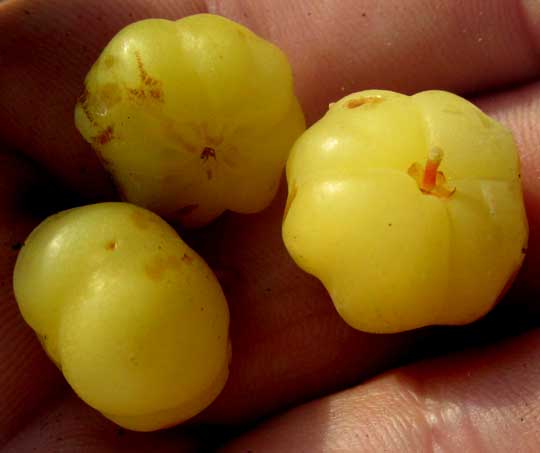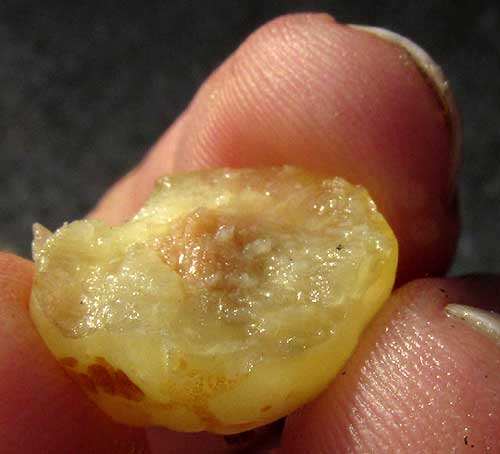Excerpts from Jim Conrad's
Naturalist Newsletter

from the March 8, 2015 Newsletter issued from Río Lagartos, on the Yucatan Peninsula's northern coast (~N21.60°, ~W88.16°), Yucatán state, MÉXICO
GOOSEBERRY-TREE
On a backstreet a couple of blocks from where I stay a certain small tree that has lost all of last season's leaves, this week has been loaded with yellow, cherry-sized fruits, as shown below:

Some branches already are issuing the upcoming season's leaves, which are pinnately compound. The tree's bright, yellow fruits and fresh, green leaves are pretty to see against our normally blue sky, as seen at the top of this page. The fruits dangle in attractive clusters, shown below:

Up closer you see that the fruits are curiously angled, or ribbed, as shown below:

Biting into the fruit you find a large, hard, woody, shallowly grooved item in the center to which the fruit's fibers strongly attach, as shown below:

In Spanish our tree is called Grosello. Maybe the best English name is Gooseberry-Tree, even though our tree is not closely related to the Gooseberry plants Northerners know. Our Gooseberry-Tree is PHYLLANTHUS ACIDUS, a member of the Spurge or Euphorbia Family, the Euphorbiaceae, while the North's gooseberry trees belong to the Currant Family, the Grossulariaceae. Gooseberry-Trees are planted in warmer zones worldwide, and go by many names. Another English name frequently encountered for it is Otaheite Gooseberry, the word "Otaheite" being an early name for the Pacific island Tahiti.
Gooseberry-Tree has been so widely planted for so long that its native land isn't known, though some suppose it might have come from Madagascar. The species spread through much of southern Asia in prehistoric times and gradually made its way among Pacific Islands. It's said to have been first brought into the Caribbean in 1793 when Captain William Bligh carried the plant from Timor to Jamaica.
In the Yucatan's little Maya villages you don't see this tree as commonly as other fruit-bearing trees, but probably most towns have at least one, for the fruits are very acidy and can be made into a drink similar to lemonade, or candied with lots of sugar. Some people who can stand the tartness nibble the fruits raw. In certain cultures the fruits are soaked in salt or vinegar-salt solution and sold along roads, though I've not seen that here.
Different cultures use it medicinally in different ways. The online Atlas de las Plantas de la Medicina Tradicional Mexicana reports that in the Yucatan it's used against diarrhea and as a disinfectant. In Quintana Roo, where Cancún is located, a tea is made from the flowers to cure coughs.
Botanically, the fruit is unusual. With such a hard center it seems similar to a one-seeded cherry, which is a drupe. However, the hard thing in the fruit's center isn't a typical seed such as a drupe would have. The object's hard cover normally surrounds six to eight smooth seeds, instead of just one. Such fruit sometimes are said to be "drupaceous," meaning "drupe-like." Technically the Gooseberry-Tree's fruit is a berry, meaning that, like the tomato, it's a pulpy fruit derived from a flower's single pistil, and contains more than one seed.